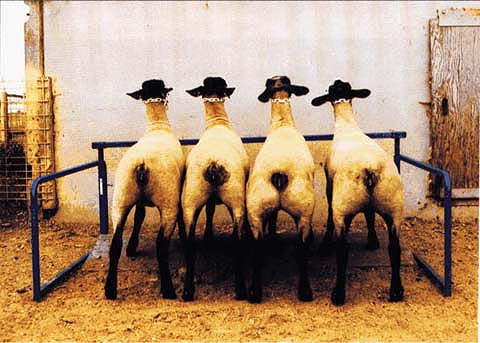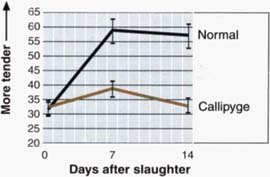All Issues
Callipyge meat a tough sell
Publication Information
California Agriculture 55(6):23-23. https://doi.org/10.3733/ca.v055n06p23
Published November 01, 2001
PDF | Citation | Permissions
Abstract
In 1983, a sheep breeder in Oklahoma noticed a ram with exceptional muscling, especially in the hindquarters. This ram, Solid Gold, was mated to normal ewes, and the condition was passed on to their offspring. Eventually the extra muscling was found to be due to a spontaneous mutation, a natural change in the animal's genetic code. Because the muscle hypertrophy (enlargement) is most pronounced in the hindquarters, the condition was named callipyge, a Greek word meaning "beautiful buttocks." Needless to say, sheep breeders were immediately interested in the meat production potential of lambs carrying the callipyge gene.
Full text
Callipyge lambs (two on right) have enlarged muscles in the hindquarters, compared with normal lambs (two on left). However, their meat is tougher than normal lamb.
Callipyge lamb carcasses clearly yield more meat than normal lambs, but this advantage is useless if the meat is of inferior quality. Specifically, there is concern that meat from callipyge lambs is tougher than normal. Meat tenderization results from the breakdown of muscle structure (myofibrils) after slaughter, a process mediated by naturally occurring muscle enzymes (calpains) and inhibited by a protein called calpastatin. The progress of this tenderization can be assessed in the laboratory by measuring the fragmentation of myofibrillar proteins using a spectrophotometer. The myofibrillar fragmentation index generally begins at 30 (at slaughter), and must be greater than 50 for lamb to be considered tender.
Fig. 1. Postmortem changes in myofibrillar fragmentation index (y-axis) in longissimus muscles of normal and callipyge lambs. Muscles were stored at 31°F (-0.5°C) for 1, 7 or 14 days postmortem. A higher myofibrillar fragmentation index indicates greater meat tenderness.
A study was conducted at the UC Hopland Research and Extension Center (HREC) to compare the growth, carcass quality and meat quality of lambs born to HREC ewes but sired by either normal or callipyge rams using artificial insemination techniques. Six lambs of each genotype were raised with their dams until weaning and then transferred to UC Davis where they were fed until they reached market weight, and then harvested.
None of the preweaning or postweaning growth traits differed between genotypes. At slaughter, callipyge lamb carcasses had greater dressing percentages (60.5% versus 57.4%) and yields of major cuts (60.4 pounds versus 53.4 pounds), and lower total carcass fat content (23.3% versus 28.5%) as compared with normal lambs (P < 0.05). In addition, loin eye areas (4.1 square inches versus 2.8 square inches) and leg weights (25.1 pounds versus 21.4 pounds) were greater and backfats were lower (0.17 inches versus 0.27 inches) in callipyge lamb carcasses as compared with normal (P < 0.05).
Meat samples from normal lambs exhibited the expected patterns of postmortem myofibrillar fragmentation, resulting in tender meat by day 7 (fig. 1). By contrast, meat from callipyge lambs showed no fragmentation from day 1 to day 14 postmortem, resulting in tough meat. This was probably due to the higher activity of calpastatin in loin muscles from callipyge lambs as compared to normal lambs (6.6 units per gram versus 3.1 units per gram, P < 0.001).
In conclusion, lambs expressing the callipyge phenotype produce leaner, more muscular carcasses that yield more saleable quantities of meat than normal lambs. However, industry adoption of the callipyge genotype is limited by the increased toughness in some hypertrophied muscles, which seems to be related to high calpastatin activity and low myofibrillar fragmentation. Several technologies have been developed to overcome this problem, such as freezing and thawing (destroys calpastatin activity), calcium chloride injections and vitamin D feeding (increases calpain activity) and even hydrodynamic shock (physically disrupts the myofibril). So far, none of these techniques has been adopted by the packing industry because of high initial costs and uncertain benefits. Until this happens, the opportunities that the callipyge genotype offers will go unused.






